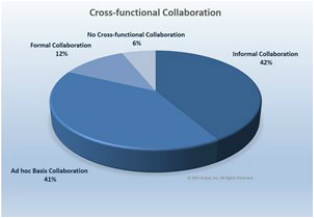 Tamara Schenk, Research Director “Collaboration” is a term that is often used but rarely defined. It means different things to different people. For some, it just means working together. Others think collaboration is an IT tool, and others think it refers to everybody discussing everything with everybody on the team. That’s not collaboration. Collaboration is not important for its own sake. The purpose of collaboration is achieving better results, ideally in a shorter amount of time. It is necessary to point this out, because if we could achieve the best results in the shortest amount of time by working alone, why would we ever collaborate with other teams, other roles or even partners? Let’s define collaboration specifically: why to collaborate (goals to be achieved), and how to collaborate (roles, teams, principles), and in which areas to achieve these goals. As an example, collaboration in a strategic account environment to drive 20% in revenue growth is different from collaboration within an enablement function to provide integrated content and training services, or collaboration in product development to develop a product innovation. The goals will always be different, and the roles and teams that are required to collaborate will be as different as the necessary collaboration process. Imagine the collaboration framework for a new product launch, the collaboration framework for creating a new value messaging playbook, or the framework required for account management to achieve 20% revenue growth in a strategic account. Collaboration frameworks, especially those in enablement, have to be tailored to the specific scope and challenges in a certain organization, always based on an enablement production process.  Sales force enablement requires lots of collaboration. But according to the data, collaboration seems to be an unleveraged potential of efficiency. We had a few surprises in the data of our CSO Insights 2015 Sales Enablement Optimization Study. The data on collaboration was one of those. A significant portion of respondents (42%) said they collaborate on an informal basis (who I know should know it). Almost as many (41%) reported ad hoc collaboration (who I think should know it). In other words, 83% of the study’s participants have no formal collaboration, collaboration framework or model in place. Only 12% of the participants reported collaborating on a formal basis (with assigned roles, accountability and responsibility), whereas 6% said they never collaborate with other functions. These “non-collaborators” were found primarily in smaller organizations or in organizations where enablement's scope was tailored to a specific function. In sales force enablement, cross-functional collaboration is the key to successfully creating various training, content and coaching services for the sales force. The more the enablement practice integrates training and content services, the more necessary it is that collaboration is defined and set-up the right way. Why an enablement production process matters as a prerequisite for a collaboration framework is explained here. Not only sales and marketing have to collaborate; many more teams, such as product management, legal or HR are required to provide various enablement services that cover the entire customer’s journey. Collaboration has a measurable impact on performance – up to 21% on quota attainment Organizations with a more formal approach to collaboration see a difference in sales performance metrics such as quota attainment, up to 21% compared to no or ad hoc collaboration. The data from our CSO Insights 2015 Sales Enablement Optimization Study provides interesting insights into the correlation between quota attainment and the collaboration approach used. In environments with ad hoc collaboration environments, 55% of the salespeople could make their quota. Taking the next step to an informal collaboration approach creates another slight rise (59%). However, implement a formal collaboration approach, and the number of salespeople achieving quota jumps up dramatically (76%). Clearly, the collaboration approach makes a difference. Between those with an ad hoc and a formal collaboration approach, there is a 21% difference in quota attainment. That’s too significant to disregard. Questions for you: How do you define collaboration in your organization? How is collaboration set up in your organization, specifically for enablement? What are the collaboration barriers, and who can remove them? Related blog posts: Conscious Collaboration—A Behavior Of World Class Sales Performers Sales Enablement and Technology – The Collaboration Gap
2 Comments
5/25/2017 07:17:36 pm
Very true! Collaboration increases the working power of teams and helps to achieve the maximum goals in a short time.
Reply
5/25/2017 07:20:10 pm
Great content! Thanks for explaining the true meaning of collaboration.
Reply
Leave a Reply. |
Categories
All
Subscribe to our Blog
Archives
March 2020
|
562.843.7801

 RSS Feed
RSS Feed
